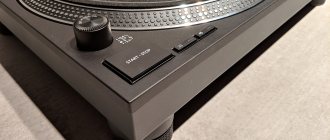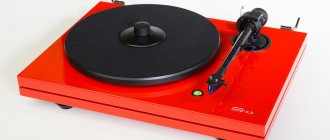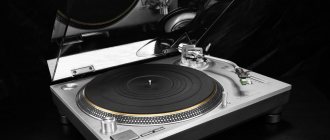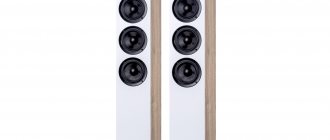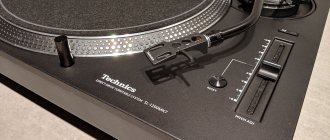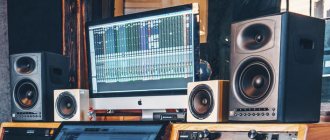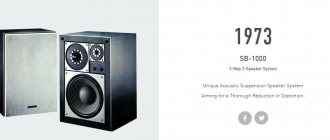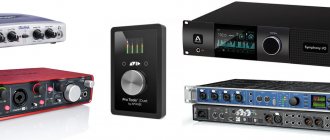VINYL - 7 STEPS TO ABSOLUTE
This article could be called “SEVEN LESSONS OF GENNADY ZUBRITSKY” - since all the steps described were made with his help and participation.
According to the level of playback, vinyl paths can be divided into four levels.
The first one is basic. This is a vinyl disc player that allows you to listen to the LP format, but not only does it not provide any advantages over digital, but also serves as a good reason to give preference to digital. I think I won’t be mistaken if I say that more than half of all vinyl paths can be classified as the first level. Eighty percent of new-made turntables, the lion's share of mass-produced phono stages, all modern cartridges in the budget up to $1000 and about three quarters of vintage turntables - all this is the basis of first-level tracts, after listening to which music lovers write messages on forums like: “Vinyl sounds no better than digital. It's just a fetish and a collectible. The numbers are louder and more dynamic. Vinyl is rotten, soapy, and crackling.”
The second level consists of decent turntables with successful phono stages, usually proprietary designs. Most often, the second level consists of vintage direct drive players with good tonearms and correctly selected MM cartridges. Second-level tracts sound more pleasant than numbers, and the presence of such a tract already justifies collecting records. A second level path can be built relatively inexpensively, and the article HIENDMUSIC'S DREAM PLAYER outlines the basic principles of such setups.
The third level is the maximum that can be squeezed out of vinyl without going broke on a top-end player and without resorting to audiophile tricks like special wiring to the tonearm or a separate armbase. A vintage direct-drive or top-of-the-range roller turntable, a good MC cartridge from $1200, a good designer or top-brand phono stage, a good step-up transformer - these are the components that make up a third-level vinyl circuit. Musical pleasure guaranteed!
All listed options are presented on the TEST DIGITIZATIONS
FIRST TRACT - corresponds to the first basic level.
TENTH TRACT - to the second level.
ELEVENTH TRACT - to the third.
The files are recorded in DSD format. To listen to this format, you can download Foobar with a pre-installed DSD plugin. You should only listen to files on a stereo system, and never through headphones!
Is it possible to rise above the third level, and does this make sense? Yes, if music is your main hobby, bordering on insanity. Believe me, you can get great pleasure from listening to records even with a second-level tract, and the third can take you to musical nirvana. Anything above this is deep audiophilia, coupled with a manic desire for the absolute. If you think this is for you, here are seven sequential steps, each of which will take your vinyl tract higher and higher.
All steps are illustrated with “before and after” digitizations made in DSD format. To listen to files in this format, you can and do not forget that digitization is just a shadow of vinyl sound.
FIRST STEP – a special stand. Surprisingly, the sound of the player changes depending on what it is placed on. I didn’t believe it myself even in my fourth year of getting into vinyl and, moreover, I tried to argue with more experienced people. “It can’t influence this! - I argued, - A plate on a heavy disk, a disk on a motor shaft, a motor in a ten-kilogram plinth, a plinth on legs and not just on legs, but on PNEUMOPODES. How can what the air legs are on affect the sound? This cannot be heard!”
It turned out that it was audible, and how. Under no circumstances should the player be placed on glass shelves. Metal ones are also not the best option. Various backfill structures such as boxes with sand are not suitable. Many people place the turntable on a granite or marble slab, and although this is closer to what it should be, the result is still not ideal. Marble adds dullness to the sound, and granite adds excessive sonority. The correct stand for a turntable, which is guaranteed to improve the sound, looks like this: three or four massive steel cones , adjustable in height. The cones are placed on a rack with their tips up and a granite slab three centimeters thick is lowered onto them. Washers are placed under the points of the cones. Felt circles are glued onto a granite slab - pads for the legs of tables and chairs are ideal. Eight to ten circles are glued around the perimeter of the slab and the same number in the central part. There is no need to achieve symmetry. The exact same marble slab is lowered on top of a slab with glued felt, and this granite-felt-marble sandwich makes the sound of the player standing on it cleaner, more transparent and clearer. It with which hiendmusic performed at hiendshow 2022 was installed. Using the link you can download two tracks recorded from the same path with the Victor TT101 player. In the first case, the player stands on a stand, in the second, it is installed on a granite-marble stand.
SECOND STEP – upgrade the tonearm wiring. The removable headshell is convenient for quickly rearranging cartridges, but if you want uncompromising sound, you'll have to get rid of this convenience. Solid wiring without a single connector, which starts from the cartridge contacts and ends with the “tulips” of the phono cable, will improve the resolution of the player by an order of magnitude. Of course, the cables should be of the highest quality possible.
Using the link you can download two tracks recorded from the same player. In the first case, silver mono-core wiring is installed in the SME tonearm and an Acrolink phono cable is connected, but there are two connectors in the circuit - a 4-pin at the place where the shell is attached and an RCA at the place where the phono cable is connected. In the second case, the tonearm has solid wiring from hiendmusic. And by the way, about shells. If you are going to make the shell permanent, then you need to install a wooden one - with such a shell the sound is much more natural. Yamamoto makes good wooden shells.
THIRD STEP – top player. If you want to move on, it's time to consider a no-compromise spinner. There should be several requirements for a top-level player: a heavy bronze disk, the heaviest possible inert base, a belt drive with the possibility of installing a Kevlar thread as a connecting link, ideally a free-standing motor and the structural possibility of installing the tonearm on a separate “tower” base. The first three requirements are met by the classic top-end Micro Seiki BL-111, and all five requirements by the Micro Seiki RX. , TW-Acoustic, TechDas, Acoustic Signature, starting with the Challenger model, Kronos Audio and direct drive Helix 1 can be considered uncompromising . The excellent roller players EMT 927 and Garrard 401 stand out - their operation very much depends on the technical condition and maintenance carried out. By the way, any vintage player needs to undergo deep preventive maintenance - the same Micro Seiki BL111 or RX plays ponderously without preventive maintenance - the sound is completely devoid of dynamics. Read more about player drives in this article .
FOURTH STEP – replacing the standard belt with a Kevlar thread. This option is available for turntables with a free-standing motor and motor speed control. The sound of a turntable with a thread is more accurate and dynamic than with a regular belt. Instrument changes show a halving of the detonation coefficient. However, with original belts the sound may seem more imposing and richer, so installing the thread is a matter of taste. In any case, it’s good when such an opportunity exists.
The link contains paired digitizations recorded from the TW Acoustic Raven AC player. Files number 1 are recorded with a Kevlar thread, files number 2 are recorded with the original belt.
STEP FIFTH - an uncompromising phono stage and step-up transformer. Hiendmusic tested many proofreaders and the test results are presented in the article THE GREAT BATTLE OF PROOFECTORS .
Follow the link - test tracks recorded with the test winner Aragorn phono stage.
SIXTH STEP - installing the tonearm on a free-standing tower stand. This measure completely decouples the tonearm from all sources of vibration and improves the resonant characteristics of the tonearm/cartridge combination. The tonearm base is machined from brass and mounted on a wooden support with rubber feet. Felt pads are placed between the base and the support - the same as between granite and marble slabs. The result is a more fundamental, clear, full sound. By following the link you can download two tracks recorded on one vinyl track. In the first case, the SME 3009 tonearm is installed on the bronze base of the turntable, in the second - on the tower stand described above.
SEVENTH STEP – installation of a 12-inch tonearm. The grooves are cut into the disc with a tangential cutter and the turning tonearm has angular error - a longer tonearm has a turning radius closer to a straight line, so the angular error is smaller. A long tonearm traditionally has a large effective mass , so it is not suitable for all cartridges. The link contains two tracks - in the first case, the Air Tight PC3 cartridge is installed on the SME 3009 tonearm, in the second - on the SME 3012. Bass and separation between mid and high frequencies are better with the 3012 tonearm, but the sound of the cartridge with 3009 is more airy and melodious. The problem is that the SME 3012 tonearm is too heavy for this cartridge. It's much better to use the lighter 12" Morch DP8 tonearm with it. The link contains test tracks recorded with this tonearm.
A top-end tract is impossible without ultra-precise tuning, which can and should be done at any stage of improvement. It is best to configure the player using the Analog Magic computer program, which is discussed in a separate article. The link contains several tracks recorded “before” and “after” - in the first case, the SME 3012 tonearm was adjusted in the usual way using templates, in the second, the same tonearm was adjusted using the Analog Magic program.
Elac Miracord 60 turntable review
Elac is one of the first manufacturers of Hi-Fi equipment in Germany. Nowadays, the company is associated mainly with the production of acoustic systems, but in the 50s-70s of the last century, Elac was one of the leaders in the production of vinyl players, its Miracord series became legendary. Modern Elac turntables include the Miracord 50, 60, 70 and 90 models. The Miracord 60 model arrived for review, based on the legendary Elac Miracord 90 model of the golden years of the last century, but with improvements based on modern technology.
Characteristics
- Disc rotation speed: 33 or 45 rpm
- Drive: belt drive
- Rotation speed accuracy: ±0.33%
- Knock coefficient: less than 0.12%
- Support plate: aluminum, 300 mm, with sub-disc, belt drive
- Pillow Bearing: Stainless Steel, Ruby Ball, Bronze Housing
- Tonearm: carbon
- Effective tonearm weight: 27.4 g
- VTA and azimuth adjustment: yes
- Stem: 18.6mm
- Pickup: optional (weight 3.5-15 g at 0.5-5 g tracking force)
- Outputs: RCA
Design Features
A massive anti-resonance MDF chassis weighing 5.5 kg is mounted on damping silicone supports. The four legs are height adjustable and hidden, as in older models, behind the aluminum protrusions of the body, which looks stylish. The cast aluminum platter is anodized, black and 22mm thick, resting on an additional platter mounted on a ruby ball bearing with a diameter of 8mm, the bearing housing being made of bronze. The drive is a classic belt drive from a DC servomotor. These motors are used infrequently and require sophisticated control electronics to perfectly maintain the selected speed. Particular attention is paid to the vibration decoupling of the motor from the chassis; the decoupling is double mechanical; the company’s own material is used. Smooth and even rotation of the platter is the basis for good sound from a turntable. The rubber belt and DC motor solution reduces or eliminates many factors that affect speed uniformity, such as vibration and line voltage fluctuations. Rotation stability is controlled and ensured automatically using a special circuit for monitoring the disk rotation speed via an optical sensor. The lightweight nine-inch carbon tonearm features precision gimbal bearings and a removable cartridge holder (shell), allowing you to experiment with third-party cartridges. The design of the tonearm provides the ability to adjust anti-skating. Unlike the initial model with index 50, the Miracord 60 player is not equipped with a built-in phono stage and does not include a pickup. It works with cartridges weighing 3.5-15 g at 0.5-5 g of clamping force.
Design
There are 3 different types of finishing color combinations available. A variant with a silver body and a black “table” arrived for review. The design is similar to that of the top-of-the-line Miracord 90, with a brushed aluminum body, black platter, tonearm, drive roller and table, and a nice-looking, black anodized metal speed selector knob. Even without budget discounts, all materials look first-class and expensive. Just two colors are enough to look modern and fresh without losing references to the golden years of vinyl.
Assembly and configuration
The player comes in one box. The support disk is packaged separately. Assembling the player is not difficult. It is necessary to place a support disk on the bushing and place a belt around the disk and pulley; a felt mat must be placed on top of the support disk. Then a counterweight and a cartridge holder with a pin connector and fixation using a special ring are installed on the tonearm. There is no need to connect any wires inside the tonearm. The head of the Audio-Technica VM530EN cartridge was pre-installed on the cartridge holder of the test sample by Audiomania specialists; all that remains is to fold up the plastic cap that protects the stylus when transporting the player. The correct vertical angle and azimuth control were pre-set when installed on the test cartridge. To set it up yourself, you will need a template, scales and other attributes of a vinyl customizer. But setting up the counterweight and anti-skating did not take much more time than reading the description of this procedure in the instructions. The transparent protective plastic cover is removable and can be installed as desired. On the back of the player there is a connector for connecting the supplied external power supply, a power button and a line output. After installing the record on the felt disc, you need to select the rotation speed with the speed switch knob, remove the tonearm from the safety lock, move it to the left (the tonearm works smoothly and freely with the correct settings) and lower the microlift lever. There is no automatic mechanism for returning the tonearm “to place” at the end of the record side; this will have to be done manually, also remembering to pause the rotation (the speed control position is between o and “45”). The engine operation during playback is silent, uniform and smooth. If you slow down the platter while rotating, it will rotate slowly for a while, indicating that the engine speed is not being adjusted too often. There are observations that this is correct; too frequent adjustment of the rotation speed can negatively affect the sound. So let's move on to the most important thing, listening!
Listening
I connect Elac Miracord 60 to the Pro-Ject Phono Box DS2 phono preamplifier, which, in turn, is connected to the linear input of the Roksan Caspian M2 integrated amplifier. Arslab Old School Superb 90 acoustic systems were used for listening.
From the first seconds of listening, I notice the sound, which, in my experience, is more characteristic of the very nature of “vinyl” sound: slightly soft, rounded lower frequencies, while it is difficult to find fault with their depth, not overwhelmingly informative, while the sound is surprisingly close to the listener and fills the whole room. I don’t want to sort this sound into categories, analyze it, I just want to listen and listen. The sound comfort is such that an experiment was successfully carried out by listening to eight sides of records in a row - absolutely no fatigue, but little was added to the analysis treasury. From what I remember: frightening, as intended, dynamic changes in “Another Brick In The Wall” by Pink Floyd, good spatiality, the effect of being at a concert from the recent “My Songs” tour by Sting, dynamic, natural sound of the piano preserving the smallest nuances Keith Jarrett recording a concert in Munich 2016. All the good old rock went with a bang - fervently, with punch and rich guitars. In three words, the sound can be described as dynamic, lively, comfortable. And in one word - spiritual. As an illustration, one of the recordings on the recorder is posted at the end of the review.
conclusions
Elac Miracord 60 leaves a positive impression of sound and operation, to get a good result you only need to make an initial setup, the design is balanced and solid, it looks stylish in the equipment rack and is a shining example of the harmonious combination of tradition and modernity. This is a good investment for those wanting to get into vinyl. Elac Miracord 60 sounds good enough to satisfy not only beginners, but also advanced analog audio enthusiasts for a long time. In the future, if desired, thanks to the removable cartridge holder, it is possible to experiment with pickups.
Pros : sound, construction, design, setup.
Cons : cartridge not included, lack of automatic tonearm return.
Example of sound recording:
“A little closer to Hi-Fi”: a couple of remarkable “turntables” for the home system from ELAC and Technics
We continue the series of compact reviews of vinyl players [, , , , , , , , , ]. This time we are looking at models whose cost exceeds 125 thousand rubles. These are ELAC Miracord 60 and Technics SL-1500C.
Turntable ELAC Miracord 60 – Audiomania.ru
[126,630] ELAC Miracord 60 is based on the brand's classic turntables from the golden era of Hi-Fi. First of all, we are talking about the appearance and stylization; the filling of the system, of course, uses modern technologies and approaches to designing players in this price segment.
The chassis for this model was made of MDF, and it turned out to be quite massive [5.5 kg]. A special well for the motor was cut out of the table and isolated using a two-stage vibration damper. To prepare the latter, they also involved ELAC specialists, who work on suspensions for speakers of this brand. The motor driving the belt was equipped with a PID controller that takes into account the rotation speed of the disk using an optical sensor.
The 300 mm support disk, 22 mm high, is made of aluminum alloy. Provided electronic adjustment of rotation speed [33 / 45 rpm].
As can be seen in the close-ups in the video review and in other photographs [for example, in a detailed review from Stereo.ru journalists], a modern carbon fiber tonearm stands out on a minimalist table covered with piano varnish. Its effective weight is 27.4 g, there is a metal shell on the mount for quick replacement and selection of a suitable pickup. It allows the installation of a cartridge weighing 3.5-15 g and a tracking force of 0.5-5 g, plus it provides VTA, azimuth adjustments and the ability to configure anti-skating.
There are a pair of RCA sockets for output to a phono stage, integrated amplifier or AV receiver. Of course, there is a dust cover and damping supports. By the way, we have a discounted version of this turntable. This is a showcase copy with minor flaws for 99 thousand rubles [27 thousand less than the cost of the new model]. You can take it only after a personal inspection in our store.
[129,990] Technics SL-1500C is an equally interesting turntable from the Japanese brand. Here the chassis and 332 mm platter are made of aluminum. The weight of the latter is more than 20% of the total for this system [9.9 kg], and the chassis is provided in combination with a fiberglass reinforced ABS plate.
Another feature is direct drive from the engine with stabilization system and electronic speed control [33 / 45 / 78 rpm].
Turntable Technics SL-1500C – Audiomania.ru
The 230mm s-shaped tonearm - with auto-lift function - for the SL-1500C comes with an Ortofon 2M Red [7000] cartridge installed. The system is almost completely ready for use out of the box and does not require additional setup, and the tonearm has extremely accurate tracking. Its height can be easily changed if the cartridge is replaced.
This model is equipped with a built-in MM phono stage, so it can be connected directly to the line input of an AV receiver or amplifier. By the way, experts’ impressions of listening can be found in the review “What Hi-Fi?” and on Stereo.ru, and even more large pictures of the turntable components are presented here.
Other materials in our “Hi-Fi World”:
- How to visualize sound on the web: video lectures with theory and practice
- Read the sound from a packet of chips, or what is a “visual microphone”
- From games to secret messages: we discuss Easter eggs in vinyl releases
- Sounds for UI: a selection of thematic resources
- Lo-fi music streamers don't need money or a career
- Why learn to search for music without the help of streaming services?
ELAC Miracord 50 is the ideal choice for those who are building a new record collection or rediscovering the magic of discs from their existing record library. The ELAC Miracord 50 player, the most budget-friendly of the Miracord line, is designed to provide exceptionally accurate transfer of recordings from vinyl media. The carefully crafted spinner design includes a belt drive and a cast aluminum disc. The statically symmetrical tonearm with a removable holder is equipped with a moving magnet cartridge. An additional convenience is the built-in phono stage, which makes it easy to add this player to any music system. The silver case comes with a black lacquered top panel, while the black case comes with a walnut veneer top panel.
Model features:
An anti-resonance chassis designed to minimize vibration interference and acoustic feedback provides superior isolation. A low-noise DC servomotor uses a rubber belt to rotate a cast aluminum disc with a high moment of inertia. This drive ensures a stable rotation speed and a minimum detonation coefficient.
Precision tonearm and cartridge. The tonearm is a statically balanced straight tube design with precision bearings, a built-in anti-skating adjustment and a removable bayonet-type holder. The pre-installed moving magnet head cartridge requires no adjustment and maintains correct vertical angle, tracking force and azimuth control from the moment the machine is turned on.
Built-in phono stage. Unlike most turntables, the ELAC Miracord 50 comes with a built-in correction preamp for proper RIAA equalization. This means you get the ability to play long-playing records without the need for an additional phono stage in line preamps or in all-digital systems. Just connect the turntable to your stereo system, insert a record and enjoy its rich sound!
Modern or classic finish. The elegant appearance of the player harmonizes with any interior: the black lacquered ELAC Miracord 50 top panel is combined with a silver body, and the walnut veneer top panel is finished with black. The player is equipped with a folding, tinted dust cover.
This model will go on sale in August 2022. Technical characteristics of ELAC Miracord 50 Drive: belt Motor: DC Rotation speed: 331⁄2 and 45 rpm Servomotor: rotation speed and servo drive Rotation speed adjustment: ±1% Detonation coefficient: 0.1 % Signal to Noise Ratio: > -67 dB (A-weighted) > -60 dB (unweighted) Platter: Die-Cast Aluminum Platter Diameter: 300mm CARTRIDGE Type: Audio-Technica AT90 Moving Magnet Stylus Design: Diamond Mounted Mount: half-inch Frequency response: 20 Hz – 20 kHz Channel separation: >18 dB Channel balance: 2.5 dB Vertical angle: 20° Allowable load impedance: 47 kOhm
PHONO EQUIPMENT Type: Moving Magnet (MM) Cartridge Output: 2.5 mV (1 kHz, 3.54 cm/s) Line Out: 140 mV (-17 dBV) Cartridge/Line Outputs: Switchable Stylus Pressure: 3.5 g ± 0.5 g Cartridge Weight : 5.0 g ± 0.5 g Cartridge weight: 11.0 g (including screws, nuts and wires)
TONEARM Type: aluminum tube, statically balanced Working length: 223.6 mm Stylus pressure adjustment: 0 – 4.0 g Allowable cartridge weight: 3.5 – 6.0 g Effective tonearm weight: 27.4 g Relief: 18.6 mm Horizontal head correction angle: 25 degrees Anti-skating mechanism adjustment: provided Main bearing: stainless steel CONNECTION RCA input and RCA cable accessories included VOLTAGE 100 – 240 VAC DC, 50/60 Hz POWER CONSUMPTION 1.5 W (< 0.5 W in standby mode) DIMENSIONS (WIDTH) 420 mm WEIGHT approx. 3.9 kg
